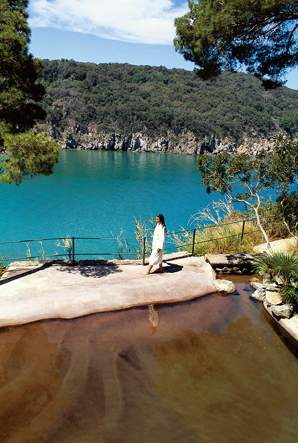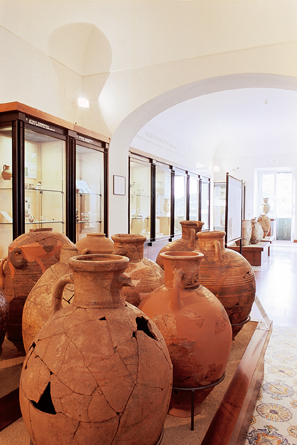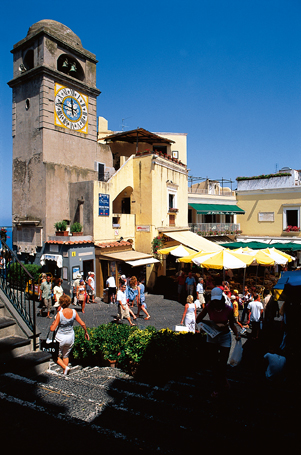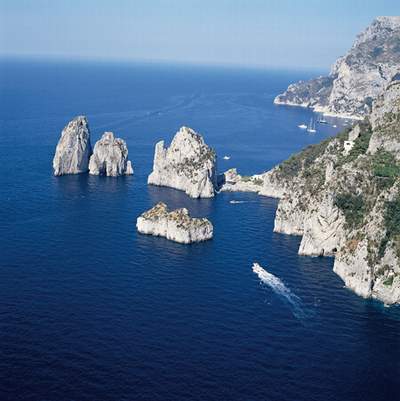 |
Procida. Ischia e Capri |
| All different, due to their diverse natural charactaristics and attractions, the three islands are a must for any tourist in search of excitement: from the evocative Procida to the health spas of Ischia, to the mythical Capri, rich with Roman remains and immersed in exceptional natural beauty. |
| Related images (19) |
|
Legendary places, rife with history, whose fascination only grows with time. All three can be reached from Naples or from Pozzuoli. Procida and Ischia, known as the Phlegrean islands, are north of the Gulf, in front of Pozzuoli. Capri is in front of the Sorrentine Peninsula. Procida
Compared to Ischia and Capri, famous tourist destinations, Procida still today seems like an island “to discover”, fascinating for its quiet streets, the vivid colours of the ancient buildings and the villages clinging to the rocks above the little ports. The rich vegetation that acts as backdrop for the mediterranean architecture, the pristine and splendid sea and the beautiful boulders of the coast, all make for unusual and exciting scenery. The Port of Sancio Cattolico, also known as Marina Grande, is where the boats that arrive from Naples and Pozzuoli dock. The brightly coloured houses that face the sea are the first images that welcome the visitor. This fishing village is dominated by the Castle that sits on the top of a sheer cliff overlooking the sea, on the inside of the highest part of the island, Terra Murata, heart of the island. This unusual quarter-city, that encloses medieval houses with courtyards and gardens, churches, buildings and a castle, has remained more or less intact for three hundred years. Entering the city by its little alleys one is overcome by the magic of a rhythm of life from another era. From the belvedere the view is enchanting. The small port of Corricella is very characteristic, with its delightful architecture of intricate little houses one upon the other: intertwining alleys on to which doors and windows open make it seem like a natural stage setting. The favourite place for bathers is the Marina di Chiaiolella, a lovely semicircular inlet closed by the old Santa Margherita promontory. The waterfront is the preferred promenade of the island. Separated from the Chiaiolella by a narrow strip of sea is the Procida lido, a busy bathing establishment. A long bridge unites la Chiaiolella with the islet of Vivara, an oasis protected by the WWF (Permission from the City of Procida is required to visit it). Ischia The largest island in the Gulf of Naples is a very popular destination and is visited in all seasons by travellers from all over the world, thanks also to its particularly mild climate. The thermal wealth of the island is immense: 29 basins, and hundreds of mineral springs and fumaroles. The use of the thermal-mineral waters for therapeutic reasons is ages old, and has contributed to spreading of the island’s fame the world over. It has attracted the attention of travellers fascinated with the idea of treating their ills naturally and amidst an enchanted and uncontaminated scenery. Next to the baths, in fact, the islands’ biggest claim to fame is its scenery. Breathtaking landscapes of valleys and hills, cliffs and beaches, woods and mountains. The main centre is Ischia, made up of the two hubs of the Port, bathing and thermal venues, and Ponte, characteristic village dominated by the Aragonese Castle, a combination of construction from differing times closed in by a fortified wall. Enchanting are the towns of Casamicciola Terme, of the renown thermal springs, and Lacco Armeno, also famous for the curative nature of its spring waters. Here, in the beautiful Villa Arbusto, the Archaeological Museum of Pithecusae, with many precious artifacts, has its home. Ischia was, in fact, the first Tyrrhenian settlement of the Greeks, founded in the 8th century BC, with the name Pithekousa (island of the ‘pithekou’ or monkeys, or the ‘pithoi’, clay vases). Some of the most important relics of the museum date back to those times, like the famous Coppa di Nestore (Nestor’s Cup). A 5th century tower dominates the centre of town and is home to the Civic Museum. The renown beach of Citara is one of the most beautiful on the island. Near to Forio is the spectacular garden of Villa La Mortella, home of the composer Sir William Walton, projected by the famed landscape architect Russell Page. On the southern part of the island is the enchanting Sant’Angelo, a tiny fishing village now become an elegant tourist centre. Inland are Panza, in a lovely panoramic position, Serrara Fontana, from which excursions to Mount Epomeo depart, and Barano d’Ischia, on the hills that descend to the wide beach of Maronti, dotted with thermal springs and fumaroles. Mount Epomeo (788 mt) gives the island its unmistakable shape, dominates the coast below and offers breathtaking views over the Gulf of Naples. Once on the summit, a visit to the hermitage of San Nicola (15th century), entirely carved into tuff rock, is rewarding. Thanks to its climate, you can enjoy the beautiful sandy beaches of Ischia in almost any season. Food-lovers can explore the secrets of a cuisine strongly anchored in tradition and of wines produced with care by wine-makers with a true vocation.
Capri “One of the magnetic points of the earth”. That is how the writer and painter Alberto Savinio described Capri, one of the most famous islands on earth. This immense cliff that rises from the abysses is a true miracle combining earth, sky, sea and light. The marine grottoes, the Faraglioni with their extraordinary shapes, the green of the vegetation on the steep rocky slopes, the incomparable scenery, the mix of nature, art, culture, and jet-set society, make this most dreamed of and celebrated island of them all. Capri has enchanted writers, poets, musicians and painters. Many are the producers that have chosen this as set for their films, and many are the famous stars that have filled the tables of its celebrated little square, “la piazzetta”. One of the first admirers of the island was the Emperor Tiberius, who lived here during the last years of his life. The true vocation of the island was discovered in the mid 1800’s, when visitors from all over the world chose it as their home, forming a cosmopolitan colony that has spread the myth of Capri and the Blue Grotto. The most important town on the island is Capri, accessible from the dock of the Marina Grande by bus, taxi or chair-lift. The hub of town, characterised by homes with terraces and pergolas, is the famous “piazzetta”, nickname of the tiny Umberto I Square, the open-air salon of tourists and high society life. The Baroque church of Santo Stefano dominates the square, with its arabesque cupola and priceless Roman pavement, transplanted from Villa Jovis. To the right is Palazzo Cerio, dating back to 1372. The complex of the Certosa di San Giacomo is one of the finest examples of Caprese architecture. Built in the 1300’s and expanded in the 1600’s, it has a gorgeous view of the Faraglioni. In spite of the numerous reconstructions, the original lines are conserved particularly in the medieval extrados vaults, typical of Capri. The gardens of Augustus are not far away, and the view of the Faraglioni and the Marina Piccola is stunning. The park, criss-crossed by innumerable alleys and little stairways, is an oasis of green with a magnificent belvedere. From the gardens one arrives at the Marina Piccola by way of via Krupp, a tortuous street that descends to the sea. It offers enchanting glimpses of views onto the sea and the Faraglioni. The most famous walk of Capri is the one that takes you to the belvedere of Tragara, a shaded square with views over the Faraglioni and the Marina Piccola. Under Tragara begins the street that descends to the Faraglioni, the three famous rock-cliffs. The first, Stella, nearest to the coast, is 109 mt high, the middle one, Faraglione di Mezzo is 81 meters, and the third, known as Scopolo, is 104 meters high and inhabited by the rare blue lizard. Breathtaking scenery immersed in luxuriant vegetation also accompany you along the way from Capri to the Arco Naturale (Natural Arch), a scenic rock arch on a sheer cliff over the sea. The Grotta di Matermania is reached going down the stairs. It is a grandiose natural cove already consecrated in Roman times by the Cibele cult, the “great mother of the latins” (the Latins’Magna Mater). Imbedded in the rocky landscape of Masullo Point is Villa Malaparte. Built at the end of the 1930’s by Adalberto Libera for the writer Curzio Malaparte, it is still eccentric and extraordinarily modern. On the northeastern point of the island rises Villa Jovis (Jove’s Villa), the most conspicuous Roman remains on the island, ordered built by the Emperor Tiberius. You get there from the town of Capri following a long walk that passes the San Michele Church, skirts the panoramic park of Villa Astarita and then leads to the archaeological area. The grandiose ruins dominate a marvellous panorama towards the Sorrentine peninsula and are on a sheer cliff 330 meters high, known as the Jump of Tiberius, from which, it is said, the Emperor had his victims thrown. The Villa is a huge palace on many levels, with the ‘working parts’ (foyer, thermal baths, servants quarters, private apartments of the Emperor, and receiving rooms) all grouped around a central nucleus, occupied by a gigantic cistern. At Anacapri the ruins of another imperial villa, Damecuta, can be found. Anacapri, the other inhabited centre, is smaller and a more quiet town than Capri, with gracious streets, white houses immersed in green, and tranquil elegant hotels. The most important monument is the San Michele Church, built in the 1700’s and designed by Domenico Antonio Vaccaro, it has a beautiful majolica pavement. This is where the famous Villa San Michele is, built on roman ruins by Axel Munthe, the Swedish doctor and author who lived on the island for 50 years. The author set his novel, The Story of San Michele, here, helping to spread the fame of the island of Capri. The elegant and original villa is furnished with pieces from the 1700’s, as well as works of art and relics from Roman times. The garden that surrounds the house is of rare beauty.
Texts and photos are published courtesy of Ufficio Turismo Regione Campania (www.turismoregionecampania.it) | |
 |
Search other Guides |
Related subjects
| Ischia Agritourism (2) |
| Capri hotels (52) |
| Ischia hotels (177) |
| Procida hotels (7) |
| Anacapri Hotels (13) |
| Capri B&B (2) |
| Ischia B&B (1) |
| Anacapri B&B (2) |
| Ischia Campings (3) |
| Ischia Youth hostel (1) |
| Capri Residences (1) |

 Munch: The Scream Within
Munch: The Scream WithinOne of the year’s most eagerly awaited exhibitions to open its doors on 14 September 2024: Edvard Munch is back in Milan with a major retrospective after a 40-year absence.
 In the garden
In the gardenThe initiative, which is scheduled to run from June 26th to September 13th, 2020, is inaugurating a temporary space for art in Corso Matteotti 5, in Milan, in the very heart of the city.
 Perugia Travel Guide
Perugia Travel GuidePerugia is the chief town of Umbria. This beautiful town is sited on a hill in the middle of a verdant country. His central square is considered one of the most beautiful squares of Italy and history, traditions, art and nature make a unique ensemble in this town as in the whole



.jpg) Procida, the smallest and least known of these islands, has kept unaltered its mediterranean identity. With strong seafaring ties, it is an ideal destination for those seeking an out-of-the-way holiday, far from the mass tourism routes. It is geologically tied to the Phlegrean Fields area that from the west of Naples goes to Cuma. The tuff ground and the jagged coast confirm its volcanic origins.
Procida, the smallest and least known of these islands, has kept unaltered its mediterranean identity. With strong seafaring ties, it is an ideal destination for those seeking an out-of-the-way holiday, far from the mass tourism routes. It is geologically tied to the Phlegrean Fields area that from the west of Naples goes to Cuma. The tuff ground and the jagged coast confirm its volcanic origins. For its extraordinarily beautiful scenery the island has merited the name Green Island: the fertility of its terrain, which produces prized wines, also paints the island with beautiful flowers. Apart from the attraction of the scenery and its bathing facilities, that which makes Ishia a must are its thermal baths, famous for the quality of its waters and the landscape that is the backdrop for spas and thermal parks.
For its extraordinarily beautiful scenery the island has merited the name Green Island: the fertility of its terrain, which produces prized wines, also paints the island with beautiful flowers. Apart from the attraction of the scenery and its bathing facilities, that which makes Ishia a must are its thermal baths, famous for the quality of its waters and the landscape that is the backdrop for spas and thermal parks. From the crypt of the nearby Santa Restituita Church one enters the excavations of a paleo-christian basilica and the museum’s relics that tell the story of the island from the time of the Greeks to the first Christians. Forio, less visited by mass tourism, holds on to its strong tradition of fisherman’s village. Here, on a rocky outcrop, the Santa Maria del Soccorso church stands out, with its tradition of local architecture intact. Sunset, in this little corner of paradise, with the reflected red of the blazing sun that seems to burn the white walls of the church, is a unique experience.
From the crypt of the nearby Santa Restituita Church one enters the excavations of a paleo-christian basilica and the museum’s relics that tell the story of the island from the time of the Greeks to the first Christians. Forio, less visited by mass tourism, holds on to its strong tradition of fisherman’s village. Here, on a rocky outcrop, the Santa Maria del Soccorso church stands out, with its tradition of local architecture intact. Sunset, in this little corner of paradise, with the reflected red of the blazing sun that seems to burn the white walls of the church, is a unique experience.

.jpg) Anacapri is the departure point for the chairlift and the trail that conduct you to the top of Mount Solaro (589 mt), the highest point of the island, from which the view is enchanting. A vacation on Capri is not complete without a visit to the Blue Grotto, whose enchanted cavern attracts visitors from all over the world. One can arrive by boat from the Marina Grande or by land from Anacapri, to then be transfered onto little boats able to penetrate the very low and narrow entrance to the grotto. Known to the Romans, and rediscovered in the 1800’s, it owes its fascinating aspect to a geological phenomenon that caused its lowering by about 20 meters, bringing the entrance to the cave to almost below sea level. The light, filtered by the crystalline water, fills the cave with an exceptional colour: an intense blue with silver reflections that covers everything it shines on. Not very large, 54 meters long, 14 wide and 30 high, the grotto goes inwards through the Pillar Gallery, rich with stalactites. Blessed with enchanting coves and imposing cliffs, Capri has lovely bathing establishments on its rocky shoreline and some on white sandy beaches. Some of the establishments on the rocky shore are at the Faraglioni (easily reached descending on foot from Tragara crossing a lovely stand of pines), and the Grotta Azzurra and Faro at Anacapri. Sandy beaches are to be found at Marina Grande, Marina Piccola and the Baths of Tiberius. Yet the best way to enjoy the sea at Capri and the incomparable scenery is to circle the island on a boat.
Anacapri is the departure point for the chairlift and the trail that conduct you to the top of Mount Solaro (589 mt), the highest point of the island, from which the view is enchanting. A vacation on Capri is not complete without a visit to the Blue Grotto, whose enchanted cavern attracts visitors from all over the world. One can arrive by boat from the Marina Grande or by land from Anacapri, to then be transfered onto little boats able to penetrate the very low and narrow entrance to the grotto. Known to the Romans, and rediscovered in the 1800’s, it owes its fascinating aspect to a geological phenomenon that caused its lowering by about 20 meters, bringing the entrance to the cave to almost below sea level. The light, filtered by the crystalline water, fills the cave with an exceptional colour: an intense blue with silver reflections that covers everything it shines on. Not very large, 54 meters long, 14 wide and 30 high, the grotto goes inwards through the Pillar Gallery, rich with stalactites. Blessed with enchanting coves and imposing cliffs, Capri has lovely bathing establishments on its rocky shoreline and some on white sandy beaches. Some of the establishments on the rocky shore are at the Faraglioni (easily reached descending on foot from Tragara crossing a lovely stand of pines), and the Grotta Azzurra and Faro at Anacapri. Sandy beaches are to be found at Marina Grande, Marina Piccola and the Baths of Tiberius. Yet the best way to enjoy the sea at Capri and the incomparable scenery is to circle the island on a boat.